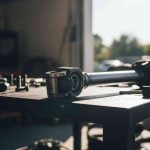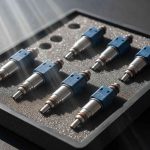Understanding Your Driveshaft: The Critical Link in Your Vehicle’s Drivetrain
The driveshaft serves as the mechanical backbone connecting your transmission to the wheels, transferring torque that enables your vehicle to move forward or backward. In both rear-wheel drive (RWD) and all-wheel drive (AWD) vehicles, this critical drivetrain part must compensate for variations in angle and length caused by vehicle maneuvering and suspension deflection while maintaining smooth, vibration-free power transfer.
When a driveshaft fails, the symptoms are unmistakable – from intense vibrations felt throughout the vehicle to clunking noises during acceleration. For budget-conscious car owners, purchasing a quality used driveshaft from reputable junkyards near me can provide significant savings while maintaining reliability.
Essential Driveshaft Parts and Their Functions
Before inspecting a used driveshaft, understanding its key parts is crucial for identifying potential issues:
- Shaft Body: The main cylindrical tube, typically made of steel or aluminum, designed to withstand high torque loads
- Universal Joints (U-joints): Cross-shaped joints at each end providing flexibility to accommodate suspension movements and angle changes
- Center Support Bearing: Found in two-piece shafts, this bearing supports the shaft mid-vehicle, preventing sagging and ensuring proper alignment
- Slip Yoke: An internally splined shaft connecting to the transfer case, allowing necessary length changes during suspension travel
- Yokes (Flange/Companion Yokes): Secure connections between the driveshaft and other powertrain parts
- Balance Weights: Attached to the shaft ensuring smooth rotation without vibration
Warning Signs of Driveshaft Failure
Recognizing the symptoms of a failing driveshaft can save you from costly repairs and potential safety hazards. Modern data science trends help automotive diagnostics, but traditional mechanical symptoms remain the most reliable indicators:
- Vibrations and Shuddering: Intense shaking felt from underneath the vehicle, often intensifying with acceleration or at specific speeds
- Clunking or Knocking Noises: Loud clunks when shifting gears, accelerating, or decelerating, typically indicating worn U-joints
- Squeaking Noises: Consistent squeaks at low speeds, often pointing to U-joints needing lubrication
- Acceleration Hesitation: Jerking or hesitation when accelerating from a stop
- Handling Issues: Difficulty turning or unusual steering behavior
- Excessive Play: Abnormal movement when the driveshaft is manually inspected
Your Complete Used Driveshaft Inspection Checklist
When purchasing a used driveshaft, thorough inspection ensures you’re getting a reliable part that won’t cause future problems. This comprehensive checklist covers all critical inspection points:
| Part | Inspection Point | What to Check |
|---|---|---|
| U-Joints | Play/Movement Test | Apply hand pressure to opposing yoke ends. No independent rotational movement should occur. Joints should move smoothly without binding. |
| Center Support Bearing | Movement/Visual Inspection | Push up and pull down near the bearing mount. Look for cracked rubber, missing material, or metal corrosion. |
| Shaft Body | Straightness Check | Examine entire length for dents, bends, twists, cracks, or weld failures. Any deviation indicates balance issues. |
| Slip Yoke | Spline Wear | Test for movement in the slip joint yoke shaft. Movement indicates worn splines causing vibration under load. |
| Yokes and Fasteners | Hardware Condition | Ensure all mounting hardware is secure. Check yoke ends for cracks or damage. |
Universal Joint Inspection: The Critical Connection Points
Universal joints are the most common failure point in driveshafts. When inspecting U-joints on a used driveshaft, follow these detailed steps:
- Visual Examination: Look for rust, corrosion, or missing grease seals around the joint
- Play Test: Grasp opposing yoke ends and attempt to move them independently – any movement indicates wear
- Smoothness Check: The joint should rotate smoothly through its full range of motion without binding
- Grease Fitting Condition: Ensure grease fittings (if present) are intact and functional
- Bearing Cap Security: Check that bearing caps are properly seated and not loose
“A worn U-joint can cause vibrations that damage other drivetrain parts. Always inspect these critical connection points thoroughly before purchasing any used driveshaft.”
Center Support Bearing Assessment
For vehicles equipped with two-piece driveshafts, the center support bearing is essential for proper operation. This bearing assembly supports the driveshaft’s center, preventing sagging and maintaining alignment. When inspecting:
- Apply upward and downward pressure near the bearing mount
- Listen for grinding or rough rotation sounds
- Examine the rubber mount for cracks, deterioration, or separation
- Check the metal bracket for corrosion or structural damage
- Ensure the bearing spins freely without excessive play
Shaft Straightness and Structural Integrity
The shaft body must be perfectly straight to prevent vibrations. Even minor bends or twists can cause significant drivetrain issues. During inspection:
- Roll Test: Roll the shaft on a flat surface to identify any wobbling or irregular rotation
- Visual Inspection: Look for obvious dents, bends, or twisted sections
- Weld Examination: Check all welds, especially near yoke attachment points, for cracks or failures
- Balance Weight Security: Ensure all balance weights are firmly attached and not damaged
- Surface Condition: Minor surface rust is acceptable, but deep pitting or corrosion indicates structural weakness
Slip Yoke and Spline Wear Evaluation
The slip yoke allows the driveshaft to change length during suspension travel. Worn splines in this part can cause vibrations and eventual failure. Key inspection points include:
- Examine spline teeth for wear, chipping, or rounding
- Check for excessive play between male and female splines
- Look for scoring or galling on spline surfaces
- Verify the seal condition to prevent fluid leaks
- Ensure smooth sliding action without binding
Professional Tips for Driveshaft Removal and Installation
When removing a driveshaft from a donor vehicle, proper phasing marks are crucial. Mark the relationship between the slip yoke/transmission end and the differential end before removal. This ensures correct reinstallation and prevents vibration issues. Many experienced mechanics recommend using white paint or a permanent marker to create alignment references.
Research from automotive data science studies shows that proper installation techniques can extend driveshaft life by up to 40%.
Where to Find Quality Used Driveshafts
Finding reliable used driveshafts requires knowing where to look. Reputable auto salvage yards typically maintain detailed inventories and can help locate parts for specific vehicle makes and models. When you’re ready to sell your current vehicle for cash for junk cars, consider salvage yards that offer both buying and selling services.
Cost Savings and Environmental Benefits
Purchasing a used driveshaft can save 50-70% compared to new parts while providing the same OEM quality and fit. This approach also supports environmental sustainability by keeping functional parts out of landfills and reducing the demand for new manufacturing.
Current trends in automotive recycling research show that used drivetrain parts maintain reliability comparable to new parts when properly inspected and maintained.
Installation and Balancing Considerations
After purchasing a used driveshaft, professional installation and balancing may be necessary. While many DIY mechanics can handle basic installation, complex balancing typically requires specialized equipment. Factor these potential costs into your budget when comparing used versus new part options.
Final Inspection Checklist Summary
Before completing your used driveshaft purchase, perform this final verification:
- U-joints: No play, smooth operation, intact seals
- Shaft body: Straight, no cracks, secure balance weights
- Support bearing: No excessive play, intact rubber mount
- Slip yoke: Smooth operation, minimal spline wear
- Overall condition: Clean, rust-free, proper phasing marks
- Compatibility: Correct length and yoke configuration for your vehicle
By following this comprehensive inspection checklist, you can confidently purchase a used driveshaft that will provide reliable service while eliminating troublesome vibrations. Remember that investing time in thorough inspection upfront can prevent costly repairs and safety issues down the road. With proper selection and installation, a quality used driveshaft can restore smooth operation to your RWD or AWD vehicle at a fraction of the cost of new parts.





Leave a Reply
You must be logged in to post a comment.